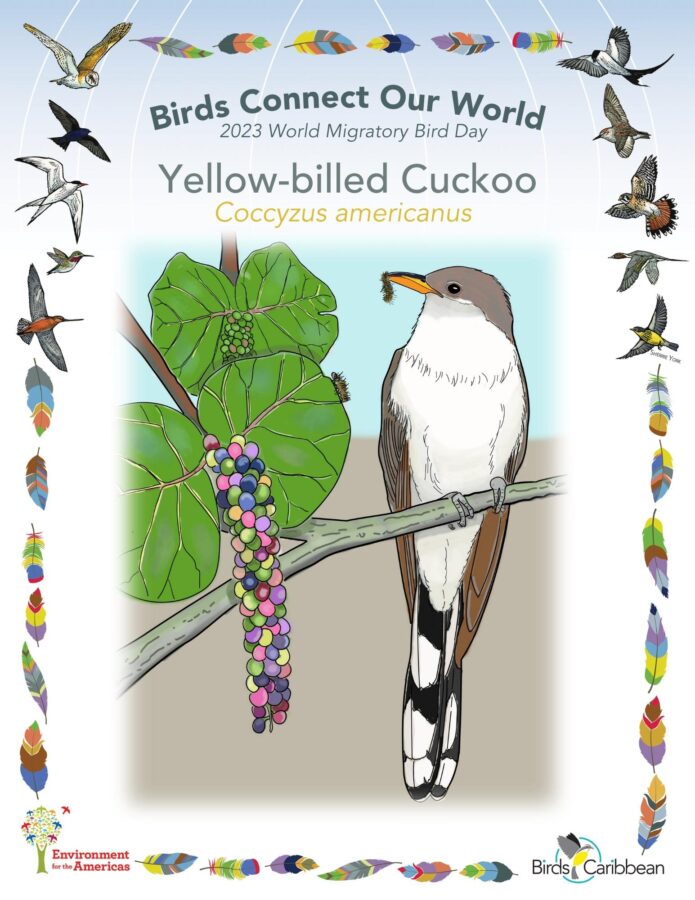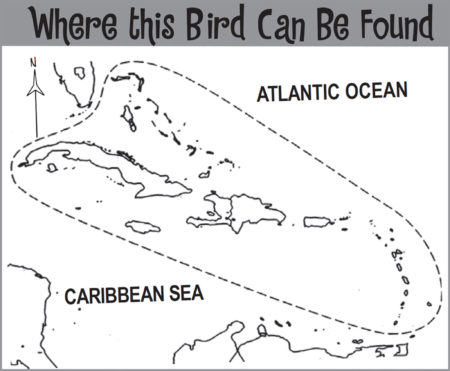Celebrate World Migratory Bird Day (WMBD) with us in 2023! This year’s theme is “Water: Sustaining Bird Life”. Have fun learning about a new migratory bird every day. We have coloring pages, puzzles, activities, and more. Download for free and enjoy nature with your family at home.
Migratory Bird of the Day: Yellow-billed Cuckoo
Hold onto your binoculars and get ready for the charming Yellow-billed Cuckoo! With its sleek brown body, white underparts, long black tail spotted white underneath, and striking down-curved yellow bill, this bird stands out in the crowd. This stealthy bird can be difficult to spot, however, as it often sits motionless for long periods of time. When disturbed, it holds its body low and moves quietly along branches, disappearing quickly into the foliage. In flight, its reddish-brown wing patches are diagnostic.
The Yellow-billed Cuckoo is quite the traveler! They breed in the eastern two/thirds of North America as well as in the Bahamas, Greater Antilles, and parts of Mexico and Central America. They winter almost entirely in South America, east of the Andes and can be seen in many Caribbean countries on migration, sometimes passing through in huge numbers.
They are caterpillar connoisseurs, chowing down on these wriggly treats like true bug busters. Their soft, hollow “cu-coo cu-coo cu-coo” calls might make you feel like you’re in the heart of the wilderness. It’s like a calming lullaby echoing through the trees. But they also have a distinct, louder and more guttural “ka-ka-ka-ka-ka-kow-kow-kowlp-kowlp-kowlp-kowlp” call. In North America it has earned the nickname ‘rain crow’ or ‘storm crow’ because it calls just before the rain and sometimes continues to call throughout the rainfall.
When love is in the air these cuckoos pair up and get straight down to business. The breeding cycle from egg laying to fledging takes only 17 days! Pairs construct flimsy nests in dense shrubs and the female usually lays 2-3 eggs.
Yellow-billed Cuckoos are well-known for their “parasitic” behavior—they sometimes lay additional eggs in other birds’ nests, both their own species and others, such as American Robin, Wood Thrush, Gray Catbird, and Red-winged Blackbird. This remarkable behavior, that is, “parasitizing” the parental care of other birds, is an adaptation for increasing their own reproductive success. Because it grows so quickly, a cuckoo chick is able to outcompete its nest mates for food. Cuckoo chicks beg vigorously and have even been observed standing on the backs of their nest mates to monopolize the parent’s feeding!
Now, let’s talk about serious stuff. The elusive Yellow-billed Cuckoo faces challenges just like other birds. Habitat loss from development is a major threat, especially on its wintering grounds. Climate change, invasive species, and pesticides (which kill and contaminate their insect prey) are also serious threats. So, what can you do? Support conservation efforts—donate to organizations that protect nature, get involved in citizen science projects, and spread the word about these incredible birds.
Together we can make sure the Yellow-billed Cuckoo continues to grace our skies for generations to come! Learn more about this species, including its range, photos, and calls here.
Thanks to Justin Saunders for the text and Christine Elder for the lovely illustration!
Color in the Yellow-billed Cuckoo
Download the Migratory Birds of the Day Coloring Page! Use the picture above and the photos on this page as your guide, or you can look up pictures of the bird online or in a bird field guide if you have one. Share your colored-in page with us by posting it online and tagging us @BirdsCaribbean #WMBD2023Carib
Listen to the calls of the Yellow-billed Cuckoo
The calls the male Yellow-billed Cuckoo are a distinctive series of hollow, wooden-sounding “ka-ka-ka-ka-ka-kow-kow-kowlp-kowlp-kowlp-kowlp” noises.
Puzzles of the Day
Click on the images below to do the puzzle. You can make the puzzle as easy or as hard as you like – for example, 6, 8, or 12 pieces for young children, all the way up to 1,024 pieces for those that are up for a challenge!
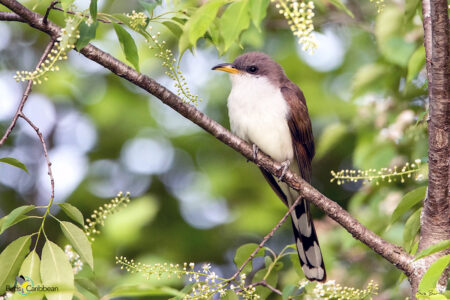
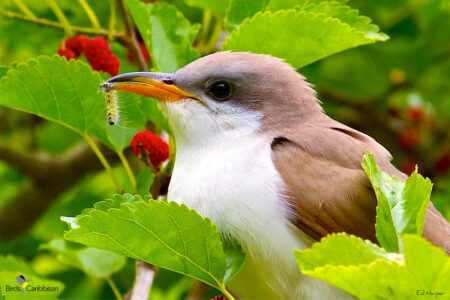
Activity of the Day
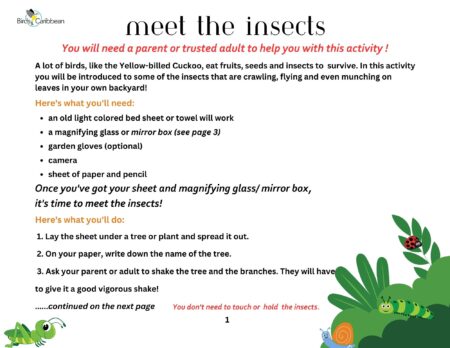 FOR KIDS: Today’s bird, the Yellow-billed Cuckoo, loves to include insects in its meals! Why not explore outside and “meet the insects” in today’s activity! You will get up close to some of those mini-beasts that are crawling, flying and even munching on leaves in your own backyard. You can download all the instructions for this activity here, including instructions for how to make your own ‘mirror box’ for looking at the insects!
FOR KIDS: Today’s bird, the Yellow-billed Cuckoo, loves to include insects in its meals! Why not explore outside and “meet the insects” in today’s activity! You will get up close to some of those mini-beasts that are crawling, flying and even munching on leaves in your own backyard. You can download all the instructions for this activity here, including instructions for how to make your own ‘mirror box’ for looking at the insects!
For this activity you’ll need:
- an old light colored bed sheet or towel will work
- a magnifying glass or mirror box (see page 3)
- garden gloves (optional)
- camera
- sheet of paper and pencil
Note: You will need a parent or trusted adult to help you with this activity!
FOR KIDS AND ADULTS: Enjoy this video of a Yellow-billed Cuckoo in the wild!
Find our more about how we celebrate World Migratory Bird Day every year: Take a trip back in time and read our round-up of BirdsCaribbean’s celebration of World Migratory Bird Day in 2020. With a global pandemic going on this was the first year when we took our celebrations online and started our series “Birds Connect Our World” featuring a “migratory bird of the day.” Find out more here:

